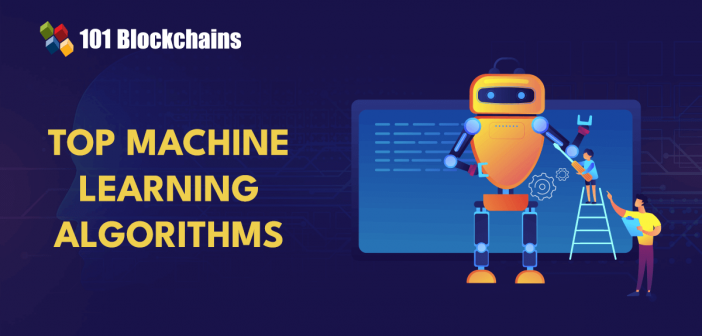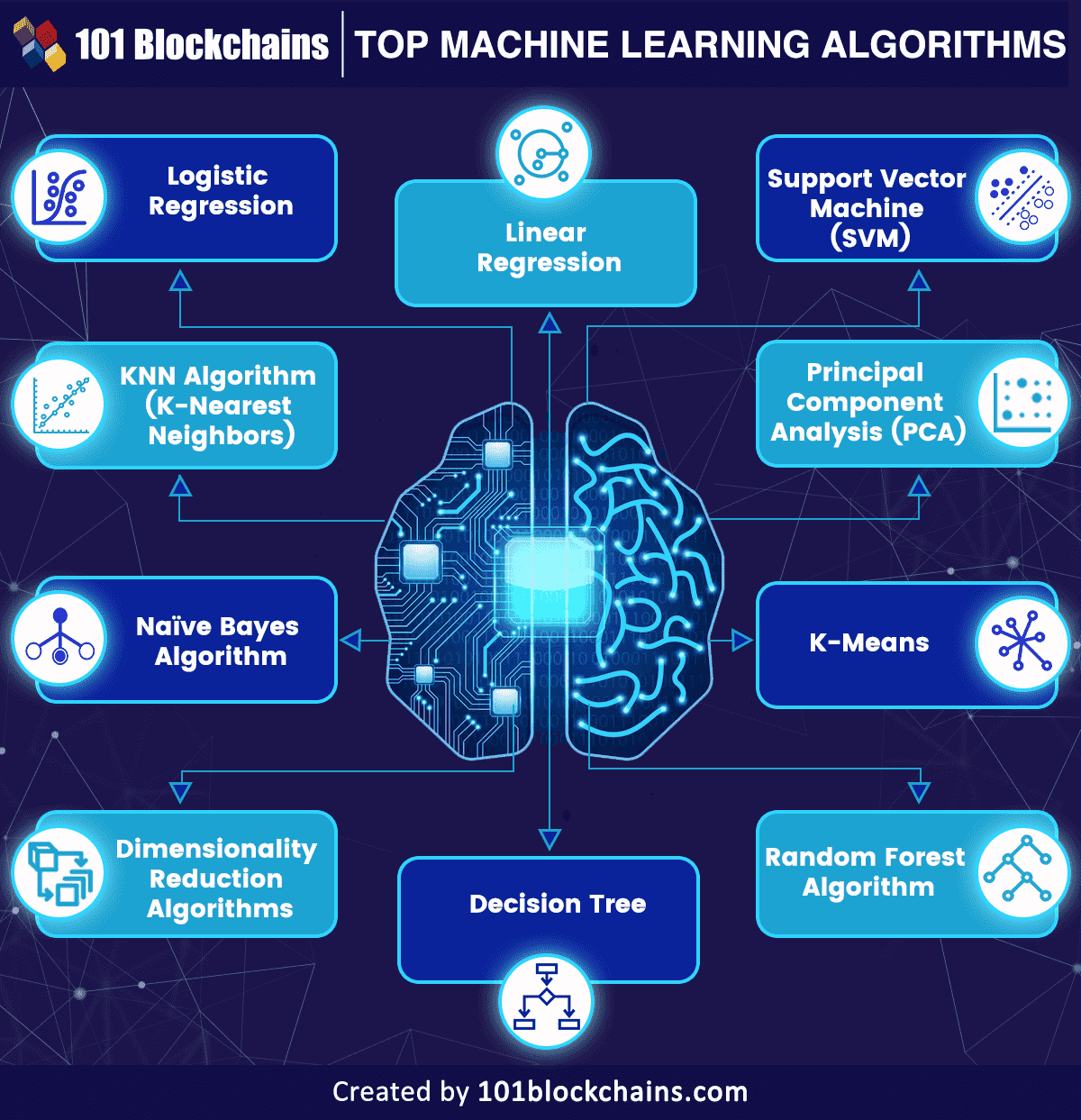Learn how blockchain truly works, master key definitions, and uncover what makes smart contracts so "smart." Dive into the fundamentals, gain valuable insights, and start your blockchain journey today!

- AI & ChatGPT
Georgia Weston
- on October 02, 2023
10 Best Machine Learning Algorithms For Beginners
The value of automation has changed the conventional perspectives about technology and its applications in our lives. Artificial intelligence and machine learning have provided a new definition of using technology to do our jobs. The advantages of the best machine learning algorithms are visible in their use cases around us. You must have noticed how computer applications could play chess and also perform surgeries through robotics.
On top of it, AI systems could become smarter on their own by learning from existing and new data. The interest of learners in machine learning has increased due to the growing popularity of machine learning and data science jobs. Machine learning is the ideal choice of technology not only in the financial services sector but also for education, healthcare, and retail.
The outline of machine learning algorithms examples would help you understand that machine learning algorithms learn from data. ML algorithms could improve with their experiences and don’t need human intervention in many cases. Therefore, the interest in machine learning algorithms has been growing as more candidates seek careers in machine learning. Let us find out the details of top ML algorithms in the following post.
Want to develop an in-depth understanding of large language models and prompt engineering techniques? Enroll now in the Certified Prompt Engineering Expert (CPEE)™ Certification
What are Machine Learning Algorithms?
Machine learning does not present any complexities in understanding the term. The term indicates the ability of machines to learn without any explicit programming. It is an important sub-discipline of artificial intelligence, which relies on algorithms for detecting patterns in data alongside adjusting the program actions.
Before exploring an ML algorithms list with algorithms for beginners, it is important to reflect on the examples of ML algorithms. The news feed of Facebook offers one of the best examples of the use of machine learning. It uses statistical or predictive analytics to identify patterns in the data of users for customizing the user’s news feed.
The search for answers to “Which ML algorithms is best for beginners?” would also guide learners toward ML algorithm components. You can find three distinct components which determine the functionalities of ML algorithms. The components of ML algorithms include representation, evaluation, and optimization. Representation of data involves tools such as decision trees, regressions, neural networks, support vector machines, and other techniques.
The evaluation component in the working mechanisms for ML algorithms focuses on accuracy, squared error, probability, margin, and many other aspects. Machine learning algorithms also involve optimization, which defines the approaches for generating programs. The techniques for optimization of ML algorithms include constrained optimization, combinatorial optimization, and convex optimization.
Take your first step towards learning about artificial intelligence through AI Flashcards
Variants of Machine Learning Algorithms
Prior to learning about the popular machine learning algorithms, it is important to learn about the variants of ML algorithms. The outline of most popular machine learning algorithms would include supervised, unsupervised, and reinforcement learning algorithms. Each algorithm has different types of techniques and could serve unique functionalities. Here is an outline of the important types of ML algorithms.
-
Supervised Learning Algorithms
Supervised learning algorithms work by using labeled training data for learning the mapping function to transform input variables into output variables. The algorithm takes input data alongside the related output labels, and the objective of the algorithm is the prediction of accurate labels. The most notable techniques in supervised learning include classification, regression, and ensemble learning.
Supervised learning models qualify as the top machine learning algorithms with the advantages of their unique techniques. For example, classification can help in predicting the outcome when output variable is available in categories. On the other hand, regression helps in predicting the outcome with the output variable available as real values, such as weight of a person. Another notable approach for supervised learning is ensembling, which involves a combination of the predictions by multiple machine learning models.
-
Unsupervised Learning Algorithms
Unsupervised learning algorithms work through an analysis of unlabeled data without any predefined output labels. The primary objective of such additions to the ML algorithms list revolves around discovering patterns, structures, or relationships in data.
The different types of unsupervised machine learning algorithms examples would point at association, dimensionality reduction, and clustering. Association helps in discovering the possibilities of co-occurrence of items in one collection and supports market-basket analysis. Clustering methods involve grouping samples in a way that objects in similar clusters are more related to each other.
The review of the best machine learning algorithms also draws attention to dimensionality reduction in unsupervised machine learning. Dimensionality reduction helps in reducing the number of variables in a dataset without compromising on transfer of important information. The common methods for dimensionality reduction include feature selection and feature extraction methods.
Want to understand the importance of ethics in AI, ethical frameworks, principles, and challenges? Enroll now in Ethics Of Artificial Intelligence (AI) Course
-
Reinforcement Learning Algorithms
Reinforcement learning algorithms are another popular addition among answers to “Which ML algorithms is best for beginners?” due to their functionalities. It helps an agent in deciding the ideal course of action according to the existing state through learning behaviors that could earn better rewards.
Reinforcement algorithms help in learning the optimal actions according to trial and error mechanisms. Some of the common use cases of reinforcement learning algorithms include gaming, autonomous systems, and robotics. The dynamic approach in reinforcement learning is one of top reasons why it can serve as a powerful technique for solving complex decision-making tasks.
-
Semi-supervised Learning
Semi-supervised learning is an advanced machine learning algorithm that helps in combining unlabeled and labeled data for training. The machine learning approach uses limited labeled data alongside larger collections of unlabeled data to improve learning process.
Unlabeled data could offer additional information alongside context for enhancing the understanding and performance of the model. Semi-supervised learning is one of the top machine learning algorithms for acquiring labeled data without time-consuming and expensive processes. Semi-supervised learning techniques can be used for different tasks, such as anomaly detection, classification, and regression.
Identify the true full potential of generative AI in business use cases and become an expert in generative AI technologies with our Generative AI Skill Path.
Top Machine Learning Algorithms
The description of different types of machine learning algorithms provides a clear impression of the power of machine learning. At the same time, it is also important to review the most popular machine learning algorithms for choosing the ideal picks. Here are some of the popular ML algorithms for beginners in 2023.

-
Logistic Regression
Logistic regression is one of the first examples of machine learning algorithms for beginners. It helps in estimation of discrete values from a collection of independent variables. In addition, logistic regression could work towards prediction of probability for an event through fitting data with a logit function.
Therefore, logistic regression is also known as logit regression. Some of the recommended methods for improving logistic regression models include elimination of features and inclusion of interaction terms. Other techniques for improving logistic regression models include utilization of non-linear models and regularization of techniques.
-
Linear Regression
Linear regression was developed for evaluation of the relationship between numerical variables in inputs and output. It became one of the top entries in an ML algorithms list for making relevant predictions according to linear regression equations. Linear regression can be represented in mathematics by a linear equation that combines a specific collection of input data for predicting the output value.
Linear equations in this ML algorithm assign factors to every set of input values, and the factors are known as coefficients. The working of linear regression involves drawing a relationship between dependent and independent variables. The linear equation helps in creating a line, also known as the regression line.
You can represent the linear equation as ‘Y= a*X + b,’ where each element has a dominant significance. The ‘Y’ in the equation represents a dependent variable, while ‘X’ represents an independent variable. The ‘a’ in the equation stands for the slope while ‘b’ represents the intercept. ‘a’ and ‘b’ are the coefficients in this equation, and you can find them by reducing the sum of squared difference of the distance between regression line and data points.
-
Support Vector Machine
Support Vector Machine or SVM is one of the popular additions among machine learning algorithms examples for beginners. Initially, SVMs were applied for data analysis use cases. The Support Vector Machine works by feeding a set of training examples in the SVM algorithm associated with a specific category. Subsequently, the algorithm would develop a model that allocates new data to one of the categories it learns during the training process.
The SVM algorithm also develops a hyperplane that could offer a difference between different categories. Processing a new data point and the type of presentation would help in classifying the data point into a specific class. In the case of trading, an SVM algorithm could be developed for classifying equity data alongside classifying test data on the basis of rules.
Want to develop the skill in ChatGPT to familiarize yourself with the AI language model? Enroll now in ChatGPT Fundamentals Course
-
KNN Algorithm
KNN or K-Nearest Neighbors algorithm is also one of the promising entries among the answers to ‘Which ML algorithms is best for beginners?” with multiple benefits. KNN algorithm leverages the complete data set as the training set rather than creating different collections of training and test sets. When you need an output for a new data instance, the KNN algorithm browses the complete dataset to find the k-nearest instances to new instances.
The algorithm could find the k number of instances that have the most similarities with the new record. It produces the output as the mean of results for regression problems or calculates the mode or more frequent class in the case of classification problems. It is important to remember that the user specifies the value of ‘k’ in the KNN machine learning algorithm. The algorithm also supports the use of Hamming distance and Euclidean distance for calculating the similarity between instances.
-
Principal Component Analysis
Principal Component Analysis, or PCA, also qualifies as one of the most popular machine learning algorithms with diverse use cases. It helps in ensuring easier opportunities for exploring and visualization of data through a reduction in the number of variables. The algorithm reduces number of variables by capturing maximum variance in data in the form of a new coordinate system.
The axes in the coordinate system or principal components serve as the major component of PCA algorithms. Every component serves as a linear combination of original variables. In addition, PCA algorithms also feature orthogonality between components which ensures zero correlation between the components.
-
Naïve Bayes Algorithm
The Naïve Bayes algorithm is a type of classifier algorithm that assumes that a specific feature in a class does not have any relation to any other feature. It is one of the best machine learning algorithms as it also features specific conditions for related features. The Naïve Bayes classifier could independently account for all properties during the calculation of probabilities for specific outputs. On top of it, Naïve Bayesian algorithms are easy to create and could perform better than classification methods on massive datasets.
Want to learn about the fundamentals of AI and Fintech? Enroll now in AI And Fintech Masterclass
-
K-Means
You should not confuse K-Means with KNN clustering algorithm. K-means is a type of unsupervised learning algorithm focused on solving clustering issues. The algorithm involves classification of datasets into a specific number of clusters. Every data point in the cluster is similar to each other and different from data points in other clusters.
-
Dimensionality Reduction Algorithms
The list of machine learning algorithms also includes effective choices like dimensionality reduction algorithms. As the volume of data increases continuously, the task of processing data to identify patterns and variables has become a challenging task. Some of the notable dimensionality reduction algorithms include factor analysis and decision trees.
-
Decision Tree
Another top addition among the top machine learning algorithms is the decision tree algorithm. It helps in classification of problems through classification of continuous dependent and categorical variables. Furthermore, the algorithm classifies population into two or multiple homogenous sets according to most important attributes or independent variables.
-
Random Forest Algorithm
The Random Forest algorithm is a collection of decision trees. You can classify new objects according to their attributes by classifying each tree that would vote for the class. Subsequently, the forest would select the classification with maximum votes as compared to other trees.
Become a master of generative AI applications and develop expert-level skills in prompt engineering with Prompt Engineer Career Path
Final Words
The review of fundamental details about machine learning algorithms and the different additions among best machine learning algorithms showcases the importance of machine learning. On the other hand, it is important to check the category of algorithms and your desired use case before choosing the algorithm. Machine learning models could offer different levels of performance according to the type of training approach and data they use. Learn more about machine learning fundamentals and explore the details of popular ML algorithms right now.





